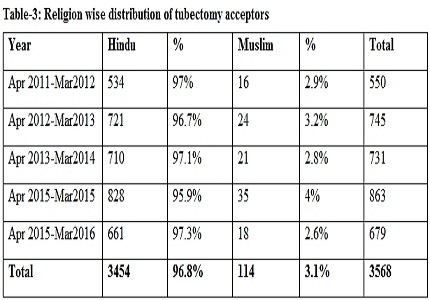A study of demographic variables affecting tubectomy in a tertiary care centre in India
Abstract
Introduction: Family planning is one of the fundamental pillars of safe motherhood and a reproductive right. The practice of family planning is influenced by socio demographic factors.
Material and Methods: All patients undergoing tubectomy were evaluated for age, parity, religion, belonging to rural/urban areas and whether undergoing tubectomy with/without MTP. Ethical clearance for the study was taken from the Institutional ethics committee. The statistical significances of differences in different variables were evaluated by calculating p-values.
Results: Study demonstrated that majority of tubectomy acceptors (86.9%) belonged to age group of 25-30 years. Maximum no of couples (44.5%) had 3 children before opting tubectomy, next predominant group was of couple who had 1-2 children (31.2%). 96.8% of couples were Hindu and only 3.1% from Muslim community. 73.6% of the total tubectomy acceptors studied, were from rural areas, and 26.3% were from urban regions. 29% of couple had medical termination of pregnancy before sterilization.
Conclusion: More of the young population in India are opting for tubectomy. Still women with 3 children are predominating the tubectomy group. Religion has a huge impact on contraceptive practices in India. Removal of the religious taboos is essential for proper implementation of family planning programmes. Maximum of the rural people are enrolling for tubectomy. There is need to spread the usage of spacing methods amongst this group. A significant no of people opted for tubectomy only when they became pregnant with the unwanted child, hence went for sterilization after medical termination of pregnancy.
Downloads
References
2. Gwatkin DR, Political will and family planning: the implications of India’s emergency experience, Population and Development Review, 1979, 5(1): 29-59.
3. India and Family Planning: An Overview (PDF), Department of Family and Community Health, World Health Organization, archived from the original(PDF) on 21 December 2009, retrieved 2009-11-25.
4. NFHS fact sheet 2015-2016, district and national survey.rchiips.org/NFHS/factsheet.shtml.
5. (National Family Health Survey. International Institute for Population Sciences, Mumbai. Available at: http://www.nfhsindia. org/factsheet.html (last accessed on April 20, 2011). Union Budget and Economic Survey. Ministry of Finance, India. Available at: http://indiabudget.nic.in (last accessed on April 15, 2011).
6. Fahim, Din Prakash Ranjan,, Namita AamTalaab, Raichur MA. A study on socio-demographic and cultural factors influencing women undergoing laparoscopic tubectomy in laparoscopic tubectomy camps conducted at UHTC. Indian Journal of Forensic and Community Medicine, January-March 2017;4(1):32-36.doi: 10.18231/2394-6776.2017.0006
7. Raina Chawla, Anjali Sunil, Shripad Hebbar, Karthik Iyer, Lavanya Rai. Int J Med Sci Public Health. 2015; 4(6): 781-786. doi: 10.5455/ijmsph.2015.15012015158.
8. Puwar B, Patel V. Factors affecting sterilisation operation among couples of a Rural area in Ahmedabad. A record based study. Indian journal of medical sciences.2012;66(11);267-72.
9. Athavale AV, Athavale SA. Factors influencing the decision to undergo tubectomy in rural Area of Maharashtra. Regional Health: Forum WHO South East Asia Region. 2003;7:42-7.
10. Swati N. Nagapurkar et al. Study of biosocial factors affecting laparoscopic tubal ligation in rural Maharashtra, India. Int J Reprod Contracept Obstet Gynecol. 2016 Dec 5(12):4461-4465.DOI: http://dx.doi.org/10.18203/2320-1770.ijrcog20164363. [PubMed]
11. Rahman S et al. Comparative Study of acceptability of contraceptive methods among married women in reproductive age in urban slum and rural area of Rani Block, Kamrup District, Assam [Thesis]”. Guwahati: Guwahati University; 2007.doi: 10.17354/ijss/2016/374
12. Anant TP, John A, Kumar D. Family Planning Practices in Rural Kerala”. Scholars Journal of Applied Medical Sciences. 2014;2(1):19–21.doi: 10.18231/2394-6776.2017.0006.
13. Speizer IS, Nanda P, Achyut P, Pillai G, Guilkey DK. Family planning use among urban poor women from six cities of Uttar Pradesh, India. J Urban Health. 2012 Aug;89(4):639-58. doi: 10.1007/s11524-011-9667-1.
14. Laxmi G et al. a study on factors influencing the choice of permanent method of family planning.” e-ISSN: 2279-0853, p-ISSN: 2279-0861.Vol14, Issue 6 Ver.V (Jun 2015),PP 16-22.DOI: 10.9790/0853-14651622.



 OAI - Open Archives Initiative
OAI - Open Archives Initiative


